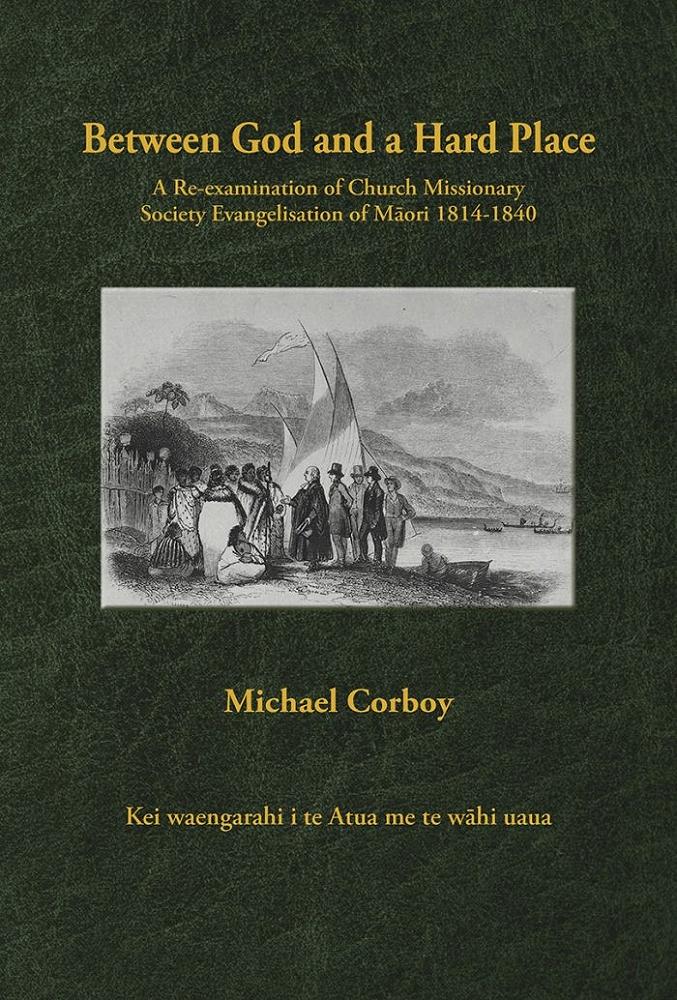
Between God and a Hard Place:
A Re-examination of Church Missionary Society Evangelisation of Māori 1814-1840
Author: Michael Corboy
Publisher: Michael Corboy, February 2022. 482 pages
Reviewer: Gary Clover
There hasn’t been a comprehensive, scholarly, chronological history of the Anglican “Church Mission” (CMS - Church Missionary Society) in New Zealand to 1840, covering its missionary personalities, mission structure, and pre-colonial Māori evangelization, since perhaps H T Purchas’s 1914 History of the English Church in New Zealand. Michael Corboy’s Between God and a Hard Place, admirably provides the up-to-date detailed narrative of the CMS Mission absent from modern historians’ mining of CMS letters and journals.
In 13 chapters Corboytraverses the story of the CMS and the scholarly debates surrounding missionary relationships and actions, Samuel Marsden’s missionary principles of “civilization” versus “evangelization”, the nature and effectiveness of Henry Williams’s leadership and emphases on missionary evangelizing after 1823, and the extent and validity of Māori conversion. He unapologetically critiques earlier scholarly analyses which he judges as “hypotheses needing validation”, to propose his own nuanced and fair assessments.
Te Awamutu-raised, and after two decades teaching in the UK, retired in the Bay of Plenty, Corboy in 1973 gained Masters honours in history and education from Waikato University – the year I gained my Masters in early Wesleyan missionary history. We’ve both spent 40 years pondering the scholarly issues surrounding Māori conversion and the missionaries’ role. We agree that modern, secular, academic historians haven’t sufficiently regarded missionary history, considering “missionaries were one of the main groups of Europeans to interact with Māori prior to 1840.”
Also that, after nine years of little progress, crucial for Northern Māori turning to Christianity was the re-emphasis by Henry Williams on missionary learning of the Māori language and translating the scriptures, preaching the Gospel in nearby villages, and teaching mission-resident younger chiefs Christian precepts while they learned to read and write te reo. For it was the “native agency” of the respected Kaikohe chief, Rāwiri Taiwhanga, which from 1830 helped bring credence and prestige to the Gospel. After gaining farming skills from Marsden at Parramatta, Taiwhanga lived within the Paihia mission from 1825 acquiring literacy skills and Christian understanding. Taking his Christian faith to Bay of Islands and Hokianga relatives greatly boosted its spread.
We agree, too, that Hongi’s death in March 1828 freed the CMS from Hongi’s stultifying patronage, allowing mission expansion beyond the North. Both missionary and Māori worldviews shared many spiritual cross-over points, especially that the all-encompassing sacred could be seen equally in missionary providence and in Māori tapu laws. But I think, important too, were trade and a prophetic, providential power encounter Ruatara experienced at Rangihoua, the ancient wahi tapu where the numinous divine touches the earth.
Unfortunately, Corboy’s writing is so extensively detailed it ended up becoming exhaustingly repetitive. Also, the Wesleyans’ testy, competitive relationship with Henry Williams is barely mentioned. Nevertheless, this scholarly CMS history, peppered throughout with black and white engravings, many from The Missionary Register, and with footnotes, an extensive index and other guides to assist reading, is an important worthy addition to the myriad of other modern scholarly studies drawn from the early CMS missionaries’ records.
The book is available from the author michaelcorboy70@gmail.com. $60 + P&P. Orders of five copies, or more, receive a discount of 25 percent.
